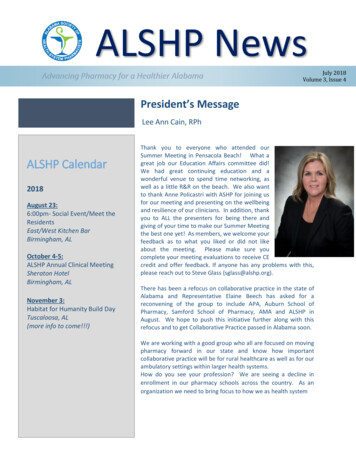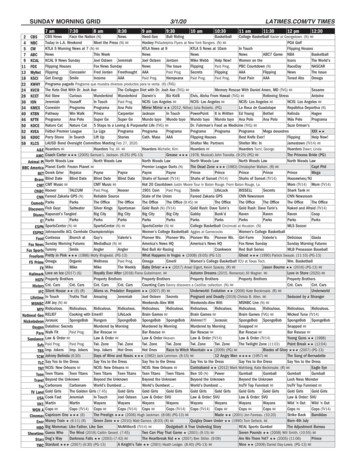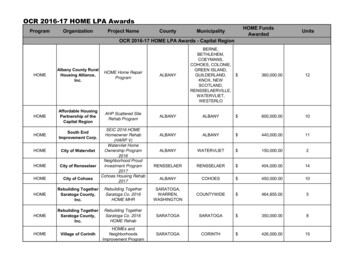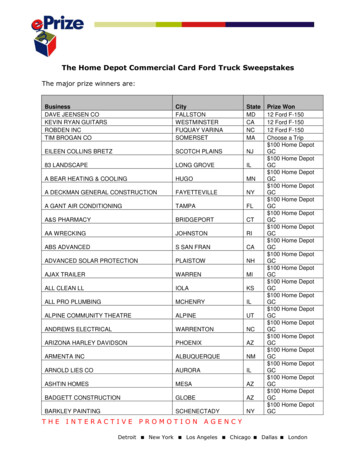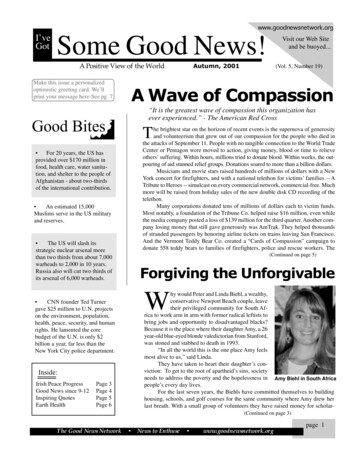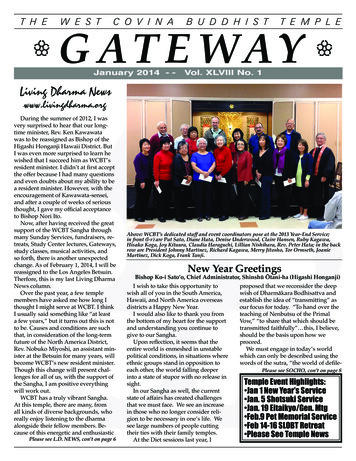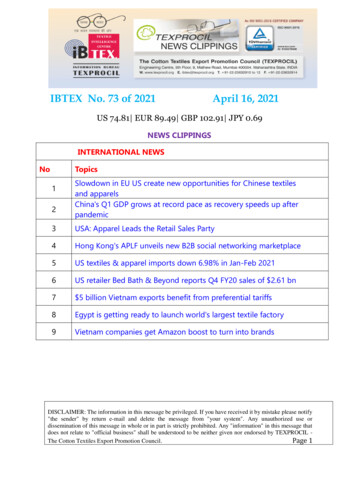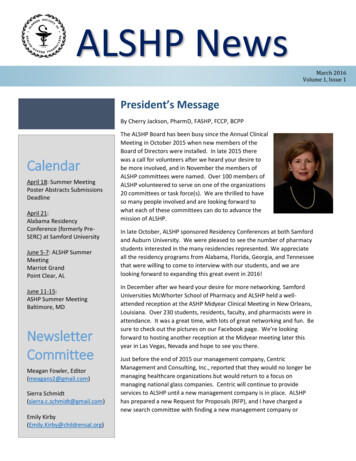
Transcription
ALSHP NewsMarch 2016Volume 1, Issue 1President’s MessageBy Cherry Jackson, PharmD, FASHP, FCCP, BCPPCalendarApril 18: Summer MeetingPoster Abstracts SubmissionsDeadlineApril 21:Alabama ResidencyConference (formerly PreSERC) at Samford UniversityJune 5-7: ALSHP SummerMeetingMarriot GrandPoint Clear, ALJune 11-15:ASHP Summer MeetingBaltimore, MDNewsletterCommitteeMeagan Fowler, Editor(meagans2@gmail.com)Sierra Schmidt(sierra.c.schmidt@gmail.com)Emily Kirby(Emily.Kirby@childrensal.org)The ALSHP Board has been busy since the Annual ClinicalMeeting in October 2015 when new members of theBoard of Directors were installed. In late 2015 therewas a call for volunteers after we heard your desire tobe more involved, and in November the members ofALSHP committees were named. Over 100 members ofALSHP volunteered to serve on one of the organizations20 committees or task force(s). We are thrilled to haveso many people involved and are looking forward towhat each of these committees can do to advance themission of ALSHP.In late October, ALSHP sponsored Residency Conferences at both Samfordand Auburn University. We were pleased to see the number of pharmacystudents interested in the many residencies represented. We appreciateall the residency programs from Alabama, Florida, Georgia, and Tennesseethat were willing to come to interview with our students, and we arelooking forward to expanding this great event in 2016!In December after we heard your desire for more networking. SamfordUniversities McWhorter School of Pharmacy and ALSHP held a wellattended reception at the ASHP Midyear Clinical Meeting in New Orleans,Louisiana. Over 230 students, residents, faculty, and pharmacists were inattendance. It was a great time, with lots of great networking and fun. Besure to check out the pictures on our Facebook page. We’re lookingforward to hosting another reception at the Midyear meeting later thisyear in Las Vegas, Nevada and hope to see you there.Just before the end of 2015 our management company, CentricManagement and Consulting, Inc., reported that they would no longer bemanaging healthcare organizations but would return to a focus onmanaging national glass companies. Centric will continue to provideservices to ALSHP until a new management company is in place. ALSHPhas prepared a new Request for Proposals (RFP), and I have charged anew search committee with finding a new management company or
ALSHP NewsMarch 2016Continued from Page 1Executive Director to represent us. While we hate to see them go we would like to thank Centric fortheir services over the past year and look forward to the next chapter in ALSHP management.By the time this newsletter is published, the ALSHP Board of Directors will have had their annualstrategic planning meeting. The stage was set for development of a new mission statement, strategicpriorities, goals and objectives in 2015. The Board challenged themselves by developing a large numberof tasks to improve ALSHP, almost all of which were achieved last year. This year’s Board will set up anumber of new tasks that the Board and committees can work on for the next three to five years. Thefocus of tasks in this year’s strategic plan will be on improving the membership and financial status ofALSHP, both of which have been significantly impacted since the economic downturn. We look forwardto reporting on our progress later this year.We hope that you are planning to attend the Summer Meeting and Exhibit Show June 5th-7th. We heardyou and your strong demand for having a summer meeting in Alabama; therefore, this year’s meetingwill be held at the Marriott Grand, Point Clear Alabama. The program committee has a great programfull of education and CE planned for the membership. There will be multiple opportunities for everyoneto come together to share research and for networking. In addition, we are excited to announce aPractice Advancement Initiative (PAI) workshop sponsored by ASHP on Monday afternoon during themeeting. The PAI workshop will be an active learning opportunity to evaluate your current healthsystem services and to create an action plan for future practice initiatives. Steven Rough, Director ofPharmacy from University of Wisconsin Hospitals and Clinics will lead us in this activity. There will besomething for everybody at the PAI workshop!The Fall Annual Clinical Meeting will be held at the Sheraton Hotel, Downtown Birmingham September29th and 30th. Be sure to mark your calendars as this is sure to be a great event.The Board of Directors looks forward to continuing to work for you throughout 2016. We appreciateyour support and hope you will help us continue to grow our membership as we continue to promote,develop, and unite pharmacy practitioners in the pursuit of providing optimal patient care in the state ofAlabama.2
ALSHP NewsMarch 2016Member Spotlight:Dr. Michael Crouch, PharmD, BCPS, FASHP;Dean, Samford University McWhorter School ofPharmacyAs interviewed by Meagan Fowler, PharmDQ: What was your motivation into becoming a pharmacist?A: I have been around pharmacy all my life. I spent many days at Crouch’sIdeal Drug Store in Asheville NC, which was owned by my grandfather andthen my father. I had the chance to see what pharmacy was all about, andthere are so many instances of servant leadership. I wanted to follow myfather’s example. I do have a couple of fond memories that really made melove independent pharmacy. One thing I recall warmly is the soda fountain.It was a common gathering place in West Asheville, and whenever I visitedthe store, the “soda jerk” would welcome me with a lime freeze. I alsoremember being amazed when my father made a prescription cream for apatient that entailed putting two different “rocks” in a mortar and pestle,which dissolved when they touched one another (a eutectic mixture). It wasneat to see chemistry in action and I wanted to learn more about how andwhy it happened.Q: Where did you attend pharmacy school? What kind of post-graduate training did you do?A: I received my Bachelor of Science in Pharmacy from the University of North Carolina followed by afirst-year residency (at that time known as a pharmacy practice residency) at Wake Forest BaptistMedical Center. I continued my education at the Medical University of South Carolina (MUSC) where Ireceived my Doctor of Pharmacy degree and completed a second-year residency focused oncardiology.Q: When did you decide you wanted to become an administrator?A: I oftentimes describe myself as a “reluctant leader.” I had various leadership positions during mypharmacy training (class president, Kappa Psi regent, chief resident), but I can’t say at any point Iwanted to become an administrator. It was during my first faculty appointment at VirginiaCommonwealth University (VCU) that I started to consider leadership opportunities in academicpharmacy.Q: What was your path to Samford?A: After completing my Doctor of Pharmacy degree and second residency at MUSC, I accepted afaculty position at VCU (Medical College of Virginia). This was a fantastic place to be a first-timefaculty member and it provided a great setting to teach students and residents as well as practicehealth system pharmacy. I had a phenomenal practice site at VCU Health System that entailedgeneral cardiology, the coronary care unit, and eventually Cardiothoracic Surgery (total artificial heart3
ALSHP NewsMarch 2016Continued from Previous Pageprogram). As mentioned previously, I started to become interested in academic leadership at VCU,and my path to Samford included stops at South University as Chair of the Department of PharmacyPractice and East Tennessee State University (ETSU) as Associate Dean of Academic Affairs and thenExecutive Associate Dean. I have been at Samford since 2014, and it is has certainly been a privilegeto serve at the McWhorter School of Pharmacy.Q: What drew you to Samford over other schools of pharmacy?A: I did not apply initially when Samford announced the dean search. It was not critical to me that I“be a dean,” and I thoroughly enjoyed my position at ETSU. As is the case with most dean searches,Samford hired an external search firm. A representative from the firm called me a couple of timesasking if I would like to apply. I was well aware of Samford’s strong reputation in pharmacy, but I wasnot looking for a new position. The search firm was persistent and after a third call from the head offirm, I decided to complete the initial questionnaire. From this initial step, I started to realize howmuch Samford and Birmingham matched my professional and personal aspirations. Once I was onSamford’s campus, I knew it was the place for me. The faculty, staff, and students were (and are)amazing, and the distinctive balance of pharmacy excellence and servant leadership impressed me.Birmingham was also a draw, and my family and I have thoroughly enjoyed our time here.Q: What is your vision for the future of the MSOP?A: The school is going through many transitions as we adapt our program to meet the ever-changingneeds of the healthcare system. During my most recent State of the School Address in January, I putforward three visions for the school.1. The Alabama Pharmacy Practice Act allows for “Collaborative Drug Therapy Management”where graduates practice at the top of their training2. All graduates have a unique and individualized education where each person is well-preparedand competitive for a position in his or her chosen area of practice3. The school has state-of-the-art facilities supporting contemporary teaching & learning,innovative service, and expanded research & scholarshipQ: How do you plan to accomplish these visions?A: Each of these goals has a different timeline and process. For vision number three, we move intonew facilities on the east side of campus in July/August, which will nicely meet our aspirationsregarding teaching, learning, service, research, and scholarship. Regarding all graduates having anindividualized education (what I call a “Personalized Pharm.D.”), this initiative started in late 2014building on our outstanding curriculum and previous growth. Examples of unique and personalizededucation include inter-professional training, certificate programs, Bachelor of Science inPharmaceutical Sciences, dual degrees, research opportunities, and global engagement. I’m pleasedwith the two dual degrees we presently offer (PharmD/MBA and PharmD/MPH) and I expectcontinued growth. I’m equally proud of our global engagement that includes 15 affiliations in ninedifferent countries, and projections show over 100 students from the school will travel abroad thisyear as part of mission trips, elective courses (e.g., London elective), and advance pharmacy practiceexperiences. For the third vision statement, the school is here to support the Alabama Board ofPharmacy and state pharmacy organizations to codify amazing pharmacy care happening in the state.4
ALSHP NewsMarch 2016Continued from Previous PageThis is obviously a shared vision, which requires the collective support of the 7500 registeredpharmacists in the state as well as faculty and students at both pharmacy schools.Q: Tell me about the new pharmacy school building on Samford’s campus. How will this change theMSOP student’s experience?A: The new facilities for the College of Health Sciences will house four schools: McWhorter School ofPharmacy, Ida V. Moffett School of Nursing, School of Public Health, and School of HealthProfessions. These shared facilities encompass over 260,000 square feet and they will provide anunparalleled learning environment to educate healthcare providers of tomorrow. A good example ofthe innovation of this space is the clinical teaching labs on the simulation floor. We will have anentire floor of more than 20,000 square feet that includes high fidelity simulation rooms, mockoperating room, simulated apartment, compounding lab, intravenous admixture lab, patientcounseling rooms, large patient assessment rooms, and provider-like offices for standardizedpatients. In addition to remarkable student spaces, faculty members will have modern labs toconduct outcomes and bench top research.Q: As post-graduate training becomes more popular and required for certain jobs, how will this affectthe curriculum and training at MSOP and other schools of pharmacy?A: We had 30 students match with a PGY1 residency last year, and I expect this number to growconsidering recommendations of ASHP and ACCP. The curriculum at McWhorter was last revisedmarkedly about five years ago. In addition to the clinical fourth year, the curriculum has a solidscience foundation, pharmacy application labs, introductory practice experiences, administrativecourses each semester, and extensive pharmacotherapy coursework. I don’t foresee any majorcurricular structure changes, although there is likely greater use of innovative teaching and learningmethods. Additionally, we have a novel co-curricular way to support students interested in residencytraining called the Postgraduate Education Residency Committee or PERC. Two to three times eachsemester faculty members, including our Associate Dean of Academic Affairs, meet with students todiscuss residencies, fellowships, and post-graduate degrees. The program has become very popularand it will continue to be one the ways we prepare students for post-graduate training.Q: As a profession, how do you feel that we as pharmacists in Alabama compare to other states?A: As I have traveled the state over the past year and a half, I have seen amazing patient careprovided by pharmacists in the community, hospital, and ambulatory care settings. Like all states, thechallenge is to ensure pharmacists can practice at the top of their training. Alabama is one of onlytwo states lacking explicit laws authorizing pharmacist collaborative practice agreements. This isparticularly important considering ongoing national legislation, specifically the Pharmacy andMedically Underserved Areas Enhancement Act (H.R. 592/S. 314). Few states would benefit morefrom passage of this national legislation than Alabama, so long as legal authority is established in thestate.5
ALSHP NewsMarch 2016Continued from Previous PageQ: What do you think the future will look like for pharmacists in Alabama in the next 5-10 years?A: In the next 5-10 years, I foresee a health system in Alabama where we fully utilize the expertise ofall providers including pharmacists. I expect pharmacists will be both recognized and reimbursed forcollaborative practice and optimization of medication outcomes. As we consider the future of thisgreat profession, the quote from Alan Kay is certainly applicable: “the best way to predict the futureis to invent it.”Call for AbstractsEach year, ALSHP sponsors a Research Poster Session at the Summer Meeting. This is a greatopportunity to share innovative ideas with others and likewise learn about up and coming trends inAlabama health-system pharmacy practice. All ALSHP members and students enrolled in an AlabamaSchool of Pharmacy are eligible to submit abstracts to be considered for presentation. The deadline forposter abstracts is April 18th, 2016 at 11:59 pm CT. Please watch for more details on abstractsubmission guidelines and instructions on the ALSHP Listserv.6
ALSHP NewsMarch 2016New Drug Update: Orkambi Author: Emily Kirby, PharmDCystic fibrosis (CF) is caused by a defect in the cystic fibrosis transmembrane conductance regulator(CFTR) channel.1 This channel is important because it allows for the transport of sodium and chloride toand from cells. In CF patients, the sodium and chloride secretion from cells is blocked causing amultitude of complications in these patients. The most notable complication is thickening of thesecretions in the airways which leads to pulmonary exacerbations often requiring hospital admissionand intravenous antibiotics. CF occurs in 1 in 3500 births in the United States, most commonly in theCaucasian population. The average lifespan in CF patients has rapidly increased to approximately 40years old over the last few decades due to increased understanding of the disease and mostimportantly, new medications affecting patients at the genetic level.2Testing for CF is now mandatory and is performed as part of newborn screenings in all 50 states. If thistest is positive, infants are referred for a “sweat test.” If this test is positive, the infant is diagnosed withCF and genetic testing is performed to identify the specific CF mutation. There are five classes ofmutations with the most common class and type being class II, F508del. Kalydeco , generic nameivacaftor, was approved by the FDA in 2012 and is used to treat patients with ten different mutationtypes, not including F508del. Orkambi , generic name lumacaftor/ivacaftor, was approved by the FDAthis year and is available for CF patients 12 years of age and older with the homozygous F508delmutation. With this mutation type being the most prevalent (found in 86% of CF patients), this drug hasthe potential to make a large impact on the CF population.2 Ivacaftor is the first drug in a class known as“potentiators”; it works at the cell surface to help the CFTR channel open, allowing chloride to leave thecell. Lumacaftor is the first drug in a class known as “correctors” and works by helping to correct themisfolding of the CFTR.The two major trials showing Orkambi’s efficacy include the TRAFFIC and TRANSPORT trials.3 The trialsincluded a total of 1122 patients aged 12 years and older with the homozygous F508del mutation. Theprimary method used to determine a CF patient’s health status is to obtain a spirometry reading of thepatients’ forced vital capacity (FVC) and forced expiratory volume in 1 second (FEV1). The trialscompared the patients’ FEV1 at baseline, 16 weeks, and 24 weeks into the trial. The patients randomizedto the Orkambi group versus placebo experienced an increase in FEV1 of 4.3 to 6.7% which wasstatistically significant. Additional positive effects were seen in patients in the Orkambi group includingfewer pulmonary exacerbations, increased body mass index (BMI), and improvement in a cystic fibrosishealth assessment survey known as CFQ-R administered to the patients. The most common side effectsobserved in the trial included cough, headache, chest tightness, diarrhea, and dyspnea.Orkambi is now available for CF patients who are 12 years and older with the homozygous F508delmutation. Orkambi is an oral tablet taken twice daily. Patients should be counseled to take themedication with a high fat meal. Patients should be informed that the most common side effects theywill experience when first starting Orkambi are chest tightness and dyspnea; these side effects shouldlessen after one to two weeks of taking the medication. A second Orkambi clinical trial is currentlyunderway in CF patients who are 6-11 years old with the homozygous F508del mutation. Additional7
ALSHP NewsMarch 2016Continued from Previous Pagemedications affecting CF at the genetic level are being studied and more information on the CF drugpipeline is available at the Cystic Fibrosis Foundation’s website.4References:1. Phan H, Kuhn RJ. Cystic fibrosis. In: Benavides S, Nahata MC, eds. Pediatric Pharmacotherapy.Lenexa, KS: ACCP; 2013: 179-189.2. 2013 CFF Patient Registry Annual Data Report. Cystic Fibrosis Foundation Web site.https://www.cff.org/2013 CFF Patient Registry Annual Data Report.pdf. Accessed August 28,2015.3. Wainwright CE, Elborn JS, Ramsey BW, et al. Lumacaftor-ivacaftor in patients with cystic fibrosishomozygous for phe508del CFTR. N Engl J Med. 2015;373(3):220-31.4. CFF Drug Pipeline. Cystic Fibrosis Foundation Web site. line/. Accessed August 23, 2015.Committee UpdatesLegislative Committee UpdateThank you to the ALSHP members who have been coming to the Board of Pharmacy meetings! Yourpresence is recognized and makes an impact. Please continue to come to the Board meetings- Two new state inspectors have been approved by the Board.- The Technician Renewal Cycle is complete. Of note, there were approximately 10,000 submissionsfor renewal with approximately 1,000 of these placed on administrative hold for 2016 due to notsubmitting proof of citizenship. These technicians will not have a paper technician license for 2016and should not be working in a pharmacy.- A large number of questions have been asked regarding whether a pharmacist may administerimmunizations outside of the pharmacy. The Board recently issued a statement specifically statingthat pharmacists are able to give immunizations outside of a pharmacy.Residents and New Practitioners UpdateThe Resident and New Practitioners Committee had its inaugural conference call (with 100%attendance). Following brief introductions, the committee discussed the dates for the AlabamaResidency Conference (ARC), which is scheduled for April 21, 2016 at Samford University. The 2nd annualNew Practitioners Research Forum was also discussed (date and time to be determined).8
ALSHP NewsMarch 2016Continued from Previous PageFinance Committee UpdateThe finance committee had its inaugural meeting (with 100% attendance!) on Tuesday, January 19th.Topics discussed included a review of the Policy and Procedure document of the Treasurer, the 2016budget, and the current financial position of the Society. Committee charges were discussed as well asaction items for the next meeting. The meeting was a great success!Newsletter Callouts Do you have someone that you think should be featured in our ‘Member Spotlight’? Pleasesend your recommendations along with a brief explanation to mstokes@uabmc.edu. Would you like to have an event added to the newsletter calendar? Please send us your ALSHPrelated events to sierra.c.schmidt@gmail.com or mstokes@uabmc.edu. Do you or one of your students have a new drug update or timely pharmacy-related article youwould like to submit for publication? Please email your articles to mstokes@uabmc.edu.9
The program committee has a great program full of education and CE planned for the membership. There will be multiple opportunities for everyone . It was during my first faculty appointment at Virginia Commonwealth University (VCU) that I started to consider leadership opportunities in academic . (PharmD/MBA and PharmD/MPH) and I expect
